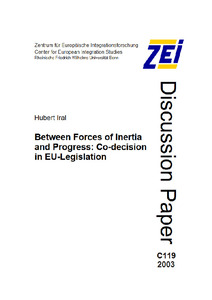Between forces of inertia and progressco-decision in EU legislation

Between forces of inertia and progress
co-decision in EU legislation

| dc.contributor.author | Iral, Hubert | |
| dc.date.accessioned | 2022-07-11T15:06:23Z | |
| dc.date.available | 2022-07-11T15:06:23Z | |
| dc.date.issued | 2003 | |
| dc.identifier.uri | https://hdl.handle.net/20.500.11811/10038 | |
| dc.description.abstract | Many observers claim that the implementation of the Co-decision mechanism with the ESA (1987) and its manifestation in the Maastricht/Amsterdam Treaties (1992/97) could be interpreted as a significant step towards more democratic legitimacy in European policymaking.
This conclusion could come close to reality under two conditions: The first, if the EP as the only directly elected decision-making body is comprehensively involved as an equal-footing Co-legislator beside the Council. The second, and even more important, is if the Co-decision procedure is sufficiently transparent for the European Citizens. Therefore, this paper aims to explore, whether these two requirements are fulfilled. The following is that a too optimistic assessment of the Codecision procedure, as a tool for more legitimacy cannot be justified. In order to demonstrate my thesis, I will firstly discuss the general problem for European Citizens with legislation at the national and European level, specifically regarding the critical question, of how the EU can bring the people closer to the Union. Secondly, it seems useful to deliver a more comprehensive description of the history of the Co-decision procedure, because this gives an insight into the development of legislation in the Community. Thirdly, the importance of the Co-decision procedure in the legislation system should be examined. In doing so, special regard should be given to its integrational significance and to the increasing impact on the structuring of the daily life of Citizens. Fourthly, I will provide an overview of the significant documents concerning the reform discussions as they arose at the end of the 90’s, especially since the of the Codecision in practice differed considerably from its intention in the Treaties. Fifthly, I will reflect on my own research on the Co-decision practice in the European Parliament and the Council in 20011 and compare the adequate Rules of procedure with how they are really practised by the both institutions. | en |
| dc.format.extent | 76 | |
| dc.language.iso | eng | |
| dc.relation.ispartofseries | ZEI Discussion Paper ; C119 | |
| dc.rights | In Copyright | |
| dc.rights.uri | http://rightsstatements.org/vocab/InC/1.0/ | |
| dc.subject | Europäische Union | |
| dc.subject | Europäische Gesetzgebung | |
| dc.subject | Europäischer Rat | |
| dc.subject.ddc | 340 Recht | |
| dc.title | Between forces of inertia and progress | |
| dc.title.alternative | co-decision in EU legislation | |
| dc.type | Arbeitspapier | |
| dc.publisher.name | Zentrum für Europäische Integrationsforschung (ZEI) | |
| dc.publisher.location | Bonn | |
| dc.rights.accessRights | openAccess | |
| dc.relation.pissn | 1435-3288 | |
| dc.relation.pisbn | 3-936183-19-8 | |
| dc.relation.url | https://www.zei.uni-bonn.de/de/publikationen/medien/zei-dp/zei-dp-119-2003.pdf | |
| ulbbn.pubtype | Zweitveröffentlichung |
Dateien zu dieser Ressource
Das Dokument erscheint in:
-
ZEI Discussion Paper (286)




